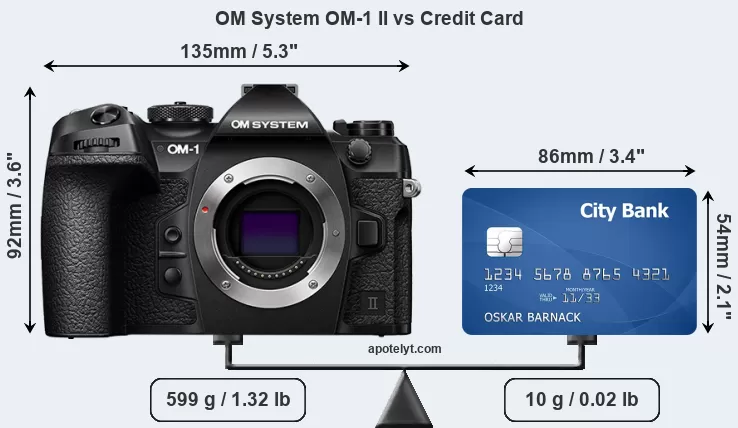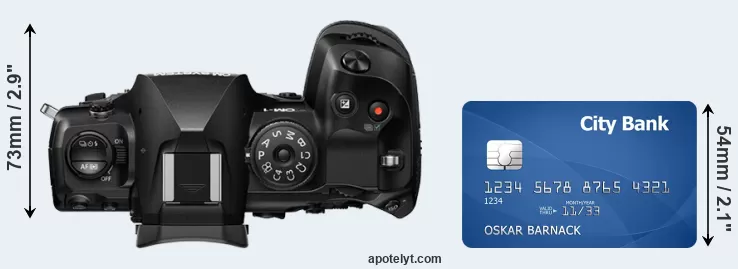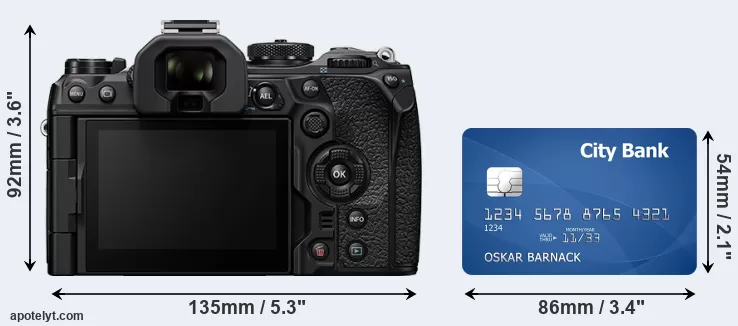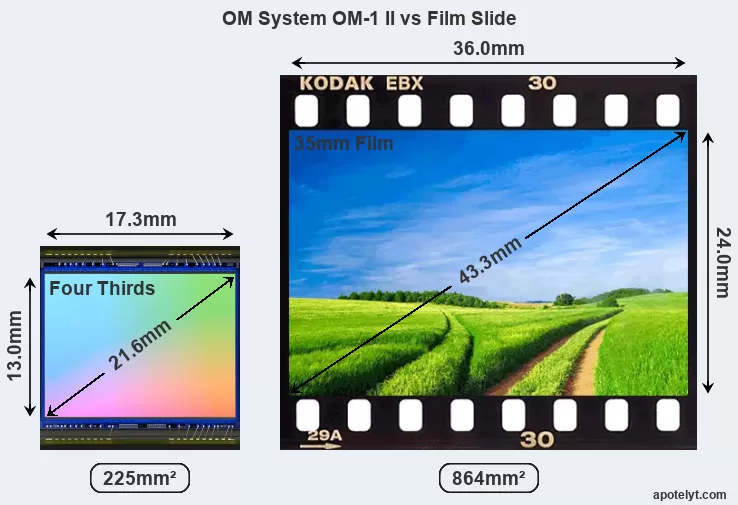OM System OM-1 II Comparison Review
The OM System OM-1 II is a mirrorless interchangeable lens camera that was officially introduced in January 2024 and is equipped with a Four Thirds sensor. It offers a resolution of 20.2 megapixel.

Is the OM System OM-1 II a good camera? The OM-1 II has a Camera Elo of 2932. This rating puts the OM-1 II among the top 20 percent of all mirrorless interchangeable lens cameras. In terms of its sensor size category (Four Thirds cameras), the OM-1 II ranks among the top 10 percent.
| OM System OM-1 II |
|---|
| Mirrorless system camera |
| Micro Four Thirds lenses |
| 20.2 MP, Four Thirds Sensor |
| 4K/60p Video |
| ISO 80 - 25 600 (80 - 102 400) |
| Electronic viewfinder (5760k dots) |
| 3.0 LCD, 1640k dots |
| Swivel touchscreen |
| 10 shutter flaps per second |
| In-body stabilization |
| Weathersealed body |
| 500 shots per battery charge |
| 135 x 92 x 73 mm, 599 g |
Read on to find out more about the camera's size, sensor, features, reception by expert reviewers, and how it compares to other digital cameras.
Body comparison with a credit card
The physical dimensions of the OM System OM-1 II relative to a credit card are illustrated in the side-by-side display below. Three consecutive perspectives from the front, the top, and the back are presented. All size dimensions are rounded to the nearest millimeter.



The table below summarizes the key physical specs of the OM System OM-1 II alongside a set of similar cameras. If you want to review a particular camera pair side-by-side, just move across to the CAM-parator tool and choose from the broad selection of possible comparisons there.

| Camera Model |
Camera Width |
Camera Height |
Camera Depth |
Camera Weight |
Battery Life |
Weather Sealing |
Camera Launch |
Launch Price |
Street Price |
||
|---|---|---|---|---|---|---|---|---|---|---|---|
| 1. | OM System OM-1 II | 135 mm | 92 mm | 73 mm | 599 g | 500 | Y | Jan 2024 | US$ 2 399 | amazon.com | |
| 2. | Canon R6 Mark II | 138 mm | 98 mm | 88 mm | 670 g | 450 | Y | Nov 2022 | US$ 2 499 | amazon.com | |
| 3. | Nikon Z6 II | 134 mm | 101 mm | 70 mm | 705 g | 410 | Y | Oct 2020 | US$ 1 999 | amazon.com | |
| 4. | Nikon Z6 III | 139 mm | 102 mm | 74 mm | 670 g | 380 | Y | Jun 2024 | US$ 2 499 | amazon.com | |
| 5. | Nikon Zf | 144 mm | 103 mm | 49 mm | 710 g | 380 | Y | Sep 2023 | US$ 1 999 | amazon.com | |
| 6. | Olympus E-M1 II | 134 mm | 91 mm | 67 mm | 574 g | 440 | Y | Sep 2016 | US$ 1 999 | ebay.com | |
| 7. | OM System OM-1 | 135 mm | 92 mm | 73 mm | 599 g | 520 | Y | Feb 2022 | US$ 2 199 | ebay.com | |
| 8. | OM System OM-5 | 125 mm | 85 mm | 50 mm | 414 g | 310 | Y | Oct 2022 | US$ 1 199 | amazon.com | |
| 9. | Panasonic GH5 | 139 mm | 98 mm | 87 mm | 725 g | 410 | Y | Jan 2017 | US$ 1 999 | ebay.com | |
| 10. | Panasonic GH5 II | 139 mm | 98 mm | 87 mm | 727 g | 400 | Y | May 2021 | US$ 1 699 | amazon.com | |
| 11. | Panasonic S5 II | 134 mm | 102 mm | 90 mm | 740 g | 370 | Y | Jan 2023 | US$ 1 999 | amazon.com | |
| Note: Measurements and pricing do not include easily detachable parts, such as add-on or interchangeable lenses or optional viewfinders. | |||||||||||
The listed prices provide an indication of the market segment that the manufacturer of the cameras have been targeting. The OM System OM-1 II was launched in the US market at a price of $2,399. Usually, retail prices stay at first close to the launch price, but after several months, discounts become available. Later in the product cycle and, in particular, when the replacement model is about to appear, further discounting and stock clearance sales often push the camera price considerably down. Then, after the new model is out, very good deals can frequently be found on the pre-owned market.

Check OM-1 II price at
amazon.com
Sensor comparison with a 35mm slide
The size of the sensor inside a digital camera is one of the key determinants of image quality. A large sensor will tend to have larger individual pixels that provide better low-light sensitivity, wider dynamic range, and richer color-depth than smaller pixel-units in a sensor of the same technological generation. Moreover, a large sensor camera will give the photographer more control over depth-of-field in the image and, thus, the ability to better isolate a subject from the background. On the downside, larger sensors are more costly to manufacture and tent to lead to bigger and heavier cameras and lenses.
The OM System OM-1 II features a Four Thirds sensor and has a format factor (sometimes also referred to as "crop factor") of 2.0. Within the spectrum of camera sensors, this places the OM System OM-1 II among the medium-sized sensor cameras that aim to strike a balance between image quality and portability.

Consistent information on actual sensor performance is available from DXO Mark for most cameras. This service determines an overall sensor rating, as well as sub-scores for low-light sensitivity ("DXO Sports"), dynamic range ("DXO Landscape"), and color depth ("DXO Portrait"). The adjacent table reports on the physical sensor characteristics and the outcomes of the DXO sensor quality tests for a sample of alternative cameras.

| Camera Model |
Sensor Class |
Resolution (MP) |
Horiz. Pixels |
Vert. Pixels |
Video Format |
DXO Portrait |
DXO Landscape |
DXO Sports |
DXO Overall |
||
|---|---|---|---|---|---|---|---|---|---|---|---|
| 1. | OM System OM-1 II | Four Thirds | 20.2 | 5184 | 3888 | 4K/60p | 23.4 | 13.6 | 1749 | 78 | |
| 2. | Canon R6 Mark II | Full Frame | 24.0 | 6000 | 4000 | 4k/60p | 25.4 | 14.6 | 3154 | 96 | |
| 3. | Nikon Z6 II | Full Frame | 24.3 | 6048 | 4024 | 4K/60p | 25.0 | 14.4 | 3303 | 94 | |
| 4. | Nikon Z6 III | Full Frame | 24.3 | 6048 | 4024 | 6K/60p | 25.4 | 14.8 | 3318 | 97 | |
| 5. | Nikon Zf | Full Frame | 24.3 | 6048 | 4024 | 4K/60p | 25.4 | 14.7 | 3243 | 96 | |
| 6. | Olympus E-M1 II | Four Thirds | 20.2 | 5184 | 3888 | 4K/30p | 23.7 | 12.8 | 1312 | 80 | |
| 7. | OM System OM-1 | Four Thirds | 20.2 | 5184 | 3888 | 4K/60p | 23.4 | 13.4 | 1553 | 77 | |
| 8. | OM System OM-5 | Four Thirds | 20.2 | 5184 | 3888 | 4K/30p | 23.4 | 13.4 | 1622 | 78 | |
| 9. | Panasonic GH5 | Four Thirds | 20.2 | 5184 | 3888 | 4K/60p | 23.9 | 13.0 | 807 | 77 | |
| 10. | Panasonic GH5 II | Four Thirds | 20.2 | 5184 | 3888 | 4K/60p | 23.7 | 13.1 | 1136 | 79 | |
| 11. | Panasonic S5 II | Full Frame | 24.0 | 6000 | 4000 | 6K/30p | 25.4 | 14.6 | 3158 | 96 | |
| Note: DXO values in italics represent estimates based on sensor size and age. | |||||||||||
Many modern cameras cannot only take still pictures, but also record videos. The OM-1 II indeed provides movie recording capabilities. The highest resolution format that the OM-1 II can use is 4K/60p.
Feature comparison
Apart from body and sensor, cameras can and do differ across a variety of features. For example, the OM-1 II has an electronic viewfinder with a resolution of 5760k dots. The viewfinder offers a field of view of 100% and a magnification of 0.82x. The following tables report on some other key feature differences and similarities of the OM System OM-1 II and comparable cameras.

| Camera Model |
Viewfinder (Type or 000 dots) |
Control Panel (yes/no) |
LCD Specifications (inch/000 dots) |
LCD Attach- ment |
Touch Screen (yes/no) |
Max Shutter Speed * |
Max Shutter Flaps * |
Built-in Flash (yes/no) |
Built-in Image Stab |
||
|---|---|---|---|---|---|---|---|---|---|---|---|
| 1. | OM System OM-1 II | 5760 | n | 3.0 / 1640 | swivel | Y | 1/8000s | 10.0/s | n | Y | |
| 2. | Canon R6 Mark II | 3690 | n | 3.0 / 1620 | swivel | Y | 1/8000s | 12.0/s | n | Y | |
| 3. | Nikon Z6 II | 3690 | Y | 3.2 / 2100 | tilting | Y | 1/8000s | 14.0/s | n | Y | |
| 4. | Nikon Z6 III | 5760 | Y | 3.2 / 2100 | swivel | Y | 1/8000s | 14.0/s | n | Y | |
| 5. | Nikon Zf | 3690 | n | 3.2 / 2100 | swivel | Y | 1/8000s | 14.0/s | n | Y | |
| 6. | Olympus E-M1 II | 2360 | n | 3.0 / 1037 | swivel | Y | 1/8000s | 18.0/s | n | Y | |
| 7. | OM System OM-1 | 5760 | n | 3.0 / 1640 | swivel | Y | 1/8000s | 10.0/s | n | Y | |
| 8. | OM System OM-5 | 2360 | n | 3.0 / 1040 | swivel | Y | 1/8000s | 10.0/s | n | Y | |
| 9. | Panasonic GH5 | 3680 | n | 3.2 / 1620 | swivel | Y | 1/8000s | 12.0/s | n | Y | |
| 10. | Panasonic GH5 II | 3680 | n | 3.0 / 1840 | swivel | Y | 1/8000s | 12.0/s | n | Y | |
| 11. | Panasonic S5 II | 3680 | n | 3.0 / 1840 | swivel | Y | 1/8000s | 9.0/s | n | Y | |
| Note: *) Information refers to the mechanical shutter, unless the camera only has an electronic one. | |||||||||||
The LCD screen on the OM System OM-1 II is flexibly attached to the body. In particular, the LCD is hinged on the side and can be flipped out for odd-angle shots in both portrait and landscape orientation. Also, this fully articulated, swivel type of LCD attachment is often appreciated by videographers for its flexibility. Moreover, v-loggers like the design because the screen can be turned to be front-facing.

One feature that differentiates the OM-1 II from many older cameras is in-body image stabilization (IBIS). The OM-1 II reduces the risk of handshake-induced blur with all attached lenses, while cameras without IBIS have to rely on optical image stabilization in OIS-equipped lenses to achieve the same effect.
Connection comparison
For some imaging applications, the extent to which a camera can communicate with its environment can be an important aspect in the camera decision process. The table below provides an overview of the connectivity of the OM System OM-1 II and, in particular, the interfaces the cameras (and selected comparators) provide for accessory control and data transfer.

| Camera Model |
Hotshoe Port |
Internal Mic / Speaker |
Microphone Port |
Headphone Port |
HDMI Port |
USB Port |
WiFi Support |
NFC Support |
Bluetooth Support |
||
|---|---|---|---|---|---|---|---|---|---|---|---|
| 1. | OM System OM-1 II | Y | stereo / mono | Y | Y | micro | 3.0 | Y | - | Y | |
| 2. | Canon R6 Mark II | Y | stereo / mono | Y | Y | micro | 3.2 | Y | - | Y | |
| 3. | Nikon Z6 II | Y | stereo / mono | Y | Y | micro | 3.2 | Y | - | Y | |
| 4. | Nikon Z6 III | Y | stereo / mono | Y | Y | micro | 3.2 | Y | - | Y | |
| 5. | Nikon Zf | Y | stereo / mono | Y | Y | micro | 3.2 | Y | - | Y | |
| 6. | Olympus E-M1 II | Y | stereo / mono | Y | Y | micro | 3.0 | Y | - | - | |
| 7. | OM System OM-1 | Y | stereo / mono | Y | Y | micro | 3.0 | Y | - | Y | |
| 8. | OM System OM-5 | Y | stereo / mono | Y | - | micro | 2.0 | Y | - | Y | |
| 9. | Panasonic GH5 | Y | stereo / mono | Y | Y | full | 3.1 | Y | - | Y | |
| 10. | Panasonic GH5 II | Y | stereo / mono | Y | Y | full | 3.2 | Y | - | Y | |
| 11. | Panasonic S5 II | Y | stereo / mono | Y | Y | full | 3.2 | Y | - | Y |
It is notable that the OM-1 II has a microphone port. Such an external microphone input can help to substantially improve the quality of audio recordings when a good external microphone is used.
Further information on the features and operation of the OM-1 II can be found in the free online OM System OM-1 II Manual or on the OM System support site.
Expert reviews
While the comparison of the spec-sheets of cameras can offer a general idea of their imaging potential, it says nothing about, for example, the handling, responsiveness, and overall imaging quality of the OM-1 II in practical situations. User reviews, such as those found at amazon, can sometimes inform about these issues, but such feedback is often incomplete, inconsistent, and biased. This is why hands-on reviews by experts are important. The following table reports the overall rankings of the cameras as published by some of the major camera review sites (amateurphotographer [AP], cameralabs [CL], digitalcameraworld [DCW], dpreview [DPR], ephotozine [EPZ], photographyblog [PB]).

| Camera Model |
AP score |
CL score |
DCW score |
DPR score |
EPZ score |
PB score |
Camera Launch |
Launch Price |
Street Price |
||
|---|---|---|---|---|---|---|---|---|---|---|---|
| 1. | OM System OM-1 II | .. | .. | .. | .. | .. | .. | Jan 2024 | US$ 2 399 | amazon.com | |
| 2. | Canon R6 Mark II | 5/5 | + + | 4.5/5 | 91/100 | 4.5/5 | 5/5 | Nov 2022 | US$ 2 499 | amazon.com | |
| 3. | Nikon Z6 II | 4.5/5 | .. | 4/5 | 89/100 | 4.5/5 | 4.5/5 | Oct 2020 | US$ 1 999 | amazon.com | |
| 4. | Nikon Z6 III | .. | .. | .. | .. | .. | .. | Jun 2024 | US$ 2 499 | amazon.com | |
| 5. | Nikon Zf | 4.5/5 | .. | 4.5/5 | 90/100 | 4.5/5 | 5/5 | Sep 2023 | US$ 1 999 | amazon.com | |
| 6. | Olympus E-M1 II | 5/5 | + + | 5/5 | 85/100 | 4.5/5 | 4.5/5 | Sep 2016 | US$ 1 999 | ebay.com | |
| 7. | OM System OM-1 | 5/5 | .. | .. | 87/100 | 5/5 | 4.5/5 | Feb 2022 | US$ 2 199 | ebay.com | |
| 8. | OM System OM-5 | 5/5 | .. | 4.5/5 | 83/100 | 5/5 | 4.5/5 | Oct 2022 | US$ 1 199 | amazon.com | |
| 9. | Panasonic GH5 | 4.5/5 | + + | .. | 85/100 | 4.5/5 | 5/5 | Jan 2017 | US$ 1 999 | ebay.com | |
| 10. | Panasonic GH5 II | 4.5/5 | .. | 4.5/5 | 85/100 | 4.5/5 | 5/5 | May 2021 | US$ 1 699 | amazon.com | |
| 11. | Panasonic S5 II | 4.5/5 | + + | 5/5 | 90/100 | 4.5/5 | 5/5 | Jan 2023 | US$ 1 999 | amazon.com | |
| Note: (+ +) highly recommended; (+) recommended; (o) reviewed; (..) not available. | |||||||||||
Care should be taken when interpreting the review scores above, though. The ratings are only valid when referring to cameras in the same category and of the same age. A score, therefore, has to be seen in close connection to the price and market introduction time of the camera, and comparisons of ratings among very different cameras or across long time periods have little meaning. It should also be noted that some of the review sites have over time altered the way they render their verdicts.

Check OM-1 II price at
amazon.com
OM System OM-1 II FAQ
Below are some additional questions and answers concerning some particular features of the OM-1 II.
What technology is the imaging sensor in the OM System OM-1 II based on?
The camera is build around a Stacked BSI-CMOS (Stacked Backside Illuminated Complementary Metal–Oxide–Semiconductor) sensor.
Which image processing chip is used in the OM System OM-1 II to convert the raw signal into an image file and perform noise reduction and image sharpening?
OM System equipped the OM-1 II with the TruePic X image processor.
What is the ISO sensitivity range of the OM System OM-1 II?
The camera has a native sensitivity range from ISO 80 to ISO 25600.
Does the OM System OM-1 II have a selfie-friendly screen?
Yes, the LCD-screen of the OM-1 II is flexible and can be turned to be front-facing for capturing selfies.
What is the life expectancy of the shutter in the OM System OM-1 II?
OM System mentions a shutter rating of 400 000 actuations for the OM-1 II. This number represents a Mean Time before Failure, that is an average value. The shutter might fail earlier, or it might last longer. Anyway, in order to exhaust the expected shutter life of the OM-1 II over, say, three years, one would have to take about 400 pictures each and every day.
How do I find the shutter count on my OM System OM-1 II?
OM System embeds the number of shutter actuations in hidden menus. You can check the number of shots that your OM-1 II has taken up to now by carefully following the steps described on the OM System OM-1 II shutter count page.
Is completely silent shooting possible with the OM System OM-1 II?
The camera has an electronic shutter option, so that it is indeed feasible to capture images without any shutter noise.
Do I need to purchase an external camera trigger to shoot time-lapse sequences with the OM System OM-1 II?
No, the OM System OM-1 II has an intervalometer built-in, so that low frequency shooting (for example, flower blooming, sunset, moon rise) can be undertaken without the need to purchase a separate external intervalometer and related software.
Is it difficult to use manual focus lenses with the OM System OM-1 II?
The OM-1 II offers focus peaking as a manual focus aid. This feature works by placing a colored highlight on in-focus zones within the image.
Does the OM System OM-1 II feature an autofocus assist light?
Yes, the camera has a lamp built-in that can illuminate the subject and improve autofocus in low-light settings.
What is the fastest shutter speed that can be used with the OM System OM-1 II for flash photography?
The OM-1 II's flash sync speed is 1/250 sec.
Does the OM System OM-1 II support the Ultra High Speed (UHS) bus interface for SD cards?
Yes, the camera can indeed use UHS-II cards, which provide for data transfer speed of up to 312 MB/s, in both of its card slots.
Which battery does the OM System OM-1 II use?
The camera gets its power from the OM System BLX-1 (here at amazon), which is a rechargeable Lithium-Ion power pack.
Is there a vertical grip available for the OM System OM-1 II?
Yes, OM System offers the HLD-10 as an optional accessory to facilitate shooting in portrait orientation and to provide additional battery power.
Where can I find the best deals for the OM System OM-1 II?
Grey imports from Asia, as found on ebay, are often very attractively priced. However, these cameras come without a warranty from OM System.
Camera to camera comparisons
If you would like to see a side-by-side review with another camera, just use the search menu below. There is also a set of direct links to comparison reviews that other users of the CAM-parator app explored.
- Canon 850D vs OM System OM-1 II
- Canon M50 Mark II vs OM System OM-1 II
- Canon SL3 vs OM System OM-1 II
- Fujifilm X-Pro1 vs OM System OM-1 II
- Hasselblad X2D 100C vs OM System OM-1 II
- Leica D-LUX 7 vs OM System OM-1 II
- Leica D-LUX 8 vs OM System OM-1 II
- Nikon B600 vs OM System OM-1 II
- Nikon W150 vs OM System OM-1 II
- OM System OM-1 II vs Panasonic G95
- OM System OM-1 II vs Panasonic GX850
- OM System OM-1 II vs Pentax K-3 III
| Camera Model | OM System OM-1 II | |
|---|---|---|
| Camera Type | Mirrorless system camera | |
| Camera Lens | Micro Four Thirds lenses | |
| Launch Date | January 2024 | |
| Launch Price | USD 2 399 | |
| Sensor Specs | ||
| Sensor Technology | Stacked BSI-CMOS | |
| Sensor Format | Four Thirds Sensor | |
| Sensor Size | 17.3 x 13.0 mm | |
| Sensor Area | 225 mm2 | |
| Sensor Diagonal | 21.6 mm | |
| Crop Factor | 2.0x | |
| Sensor Resolution | 20.2 Megapixels | |
| Image Resolution | 5 184 x 3 888 pixels | |
| Pixel Pitch | 3.34 μm | |
| Pixel Density | 8.96 MP/cm2 | |
| Moiré control | no AA filter | |
| Movie Capability | 4K/60p Video | |
| ISO Setting | 80 - 25 600 ISO | |
| ISO Boost | 80 - 102 400 ISO | |
| Image Processor | TruePic X | |
| Screen Specs | ||
| Viewfinder Type | Electronic viewfinder | |
| Viewfinder Field of View | 100% | |
| Viewfinder Magnification | 0.82x | |
| Viewfinder Resolution | 5760k dots | |
| Top-Level Screen | no Top Display | |
| LCD Framing | Live View | |
| LCD Size | 3.0 inch | |
| LCD Resolution | 1640k dots | |
| LCD Attachment | Swivel screen | |
| V-logging Friendliness | Front-flip possible | |
| Touch Input | Touchscreen | |
| Shooting Specs | ||
| Focus System | On-Sensor Phase-detect | |
| Manual Focusing Aid | Focus Peaking | |
| Maximum Shutter Speed | 1/8000s | |
| Continuous Shooting | 10 shutter flaps/s | |
| Shutter Life Expectancy | 400 000 actuations | |
| Silent Shooting | Electronic Shutter | |
| Time Lapse Photography | Intervalometer Built-in | |
| Image Stabilization | In-body stabilization | |
| Fill Flash | no On-Board Flash | |
| Storage Medium | SDXC cards | |
| Single or Dual Card Slots | Dual card slots | |
| UHS card support | Dual UHS-II | |
| Connectivity Specs | ||
| External Flash | Hotshoe | |
| Studio Flash | PC Sync socket | |
| USB Connector | USB 3.0 | |
| HDMI Port | micro HDMI | |
| Microphone Port | External MIC port | |
| Headphone Socket | Headphone port | |
| Wifi Support | Wifi built-in | |
| Bluetooth Support | Bluetooth built-in | |
| Body Specs | ||
| Environmental Sealing | Weathersealed body | |
| Battery Type | OM System BLX-1 power pack | |
| Battery Life (CIPA) | 500 shots per charge | |
| In-Camera Charging | USB charging | |
| Body Dimensions |
135 x 92 x 73 mm (5.3 x 3.6 x 2.9 in) |
|
| Camera Weight | 599 g (21.1 oz) | |
Did you notice an error on this page? If so, please get in touch, so that we can correct the information.
You are here: Home » CAM-parator » OM System OM-1 II Review
